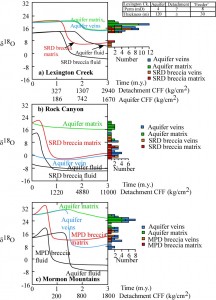Losh, S., 1997, Geol. Soc. Amer. Bull., v. 109: p. 300-323; Swanson, E., Wernicke, B., Eilers, J., Losh, S., 2012, Temperatures and fluids on faults based on carbonate clumped-isotope thermometry; Amer. Jour. Science, v. 312, pp. 1-21
The Snake Range metamorphic core complex is characterized by a thick, down-to-the-east detachment fault, active in the Miocene, that separates relatively unfaulted lower-plate Precambrian and Cambrian quartzite and limestone and Mesozoic to Oligocene intrusive rocks from highly-faulted upper-plate Paleozoic carbonates. The Snake Range detachment has tens of kilometers of offset (Bartley and Wernicke, 1984 Tectonics), and contains fault products that were formed over a temperature range of ~120 – 450 C, reflecting the tectonic exhumation of lower-plate rocks from 15 km to 2 km depth during extension and thinning of the upper plate. Thermal modeling shows that, for a fault duration of 3 m.y., the upper plate was initially heated, then cooled as it was thinned and simultaneously juxtaposed against hotter footwall rocks (Figure 1). The Mormon Peak Detachment has several km of offset mainly within a Paleozoic carbonate section, and tectonically exhumed lower-plate rocks from 8 km to 2 km depth (Wernicke et al., 1985 Tectonics).
Stable isotope data (over 200 analyses) from the fault and upper plate rocks demonstrate that the detachment system at all levels was the conduit for a large volume of meteoric water derived from the upper plate. The syntectonic hydrogeologic behavior of the detachment fault system varied from place to place. In one Snake Range location (Lexington Creek, Figure 2), the medium-bedded silty limestone “aquifer” above the detachment exchanged to a great extent with throughgoing meteoric water, decreasing in extent with increasing height above the detachment. In another Snake Range location (Rock Canyon, Figure 25), the massive limestone aquifer above the detachment was largely inert with respect to oxygen isotope exchange with detachment fluids. Fluid flow in the aquifer was largely intergranular in the former location and fracture – controlled in the latter. Detachment breccias from the two locations reflect the exchange characteristics of the overlying aquifer rocks. In the Mormon Mountains, oxygen isotope data from detachment breccias and “aquifer” rocks and veins shows a more-complex history of early intergranular flow followed by fracture-controlled flow (Figure 2).
Hydrogeologic modeling of the detachment faults, based on temperature and oxygen isotope constraints (Figure 2), shows they transmitted up to 11,000 kg fluid per square centimeter perpendicular to the flow path during the 3-million year duration of faulting. Fluid volume and temperature are comparable with epithermal ore deposit systems elsewhere. Average fault permeability was in the 5 – 20 milliDarcy range. The ubiquitous stylolitic carbonate breccia that comprises the detachment faults in the Snake Range shows two alternating modes of deformation: pressure solution that produced stylolites overprinting breccia fabric, and cataclasis that brecciated stylolitic carbonate. Multiple generations of calcite veins are present in the detachment faults.
Figure 1. Thermal model for Snake Range Detachment. The upper plate (red line) thinned from 8 km to 2 km during extension, and overlay lower-plate rocks (blue line) that were exhumed from 15 km. Total fault duration is 3 million years. Ticks show temperature-depth relations at times during faulting. This thermal model, and the geometric model from which it was derived, was part of the input for the stable isotope model.
Figure 2. Model for oxygen isotope evolution for rocks and fluids in the Snake Range Detachment at a) Lexington Creek and b) Rock Canyon, and in c) the Mormon Peak Detachment. Calculated d18O versus time and cumulative fluid flux (CFF) are compared with oxygen isotope data from the study sites shown in the histograms on the right, using the same scale as the model isotope curves. In the 2-D model, water flowed down a “feeder fault” from the surface to the detachment, and up the detachment to the sampled sites, equilibrating with carbonate aquifer and detachment rocks as it flowed. Fault permeability and its distribution between rock and fractures was varied to match model curves with data. In the models, hydraulic head, hence flux, varied with time.
Recent collaboration with geologists from Cal Tech (Swanson, Wernicke, Eilers, and Losh, 2012 Amer Jour Sci) utilized clumped isotope geochemistry to evaluate fluid temperatures and source(s) in the Mormon Peak Detachment, and essentially confirmed the findings of Losh (1997) that variably-exchanged meteoric fluids infiltrated the Mormon Peak Detachment at 100 +/- 30 C while it was active. However, the geologic setting of this fault has become a controversial subject (Anders, Schneider, Scholz, and Losh, 2013, Jour. Structural Geol.). Instead of being a rooted detachment (low-angle normal) fault that passes through the crust and has displacement of tens of km, the Mormon Peak Detachment and the overall geology of the Mormon Mountains exhibit several characteristics of the presence of large block slide complex – a form of landslide that moved thick (200 m+) blocks of rock down the flanks of the Mormon Mountains but that is not rooted in the crust. If so, the temperatures during faulting are quite high for the shallow depth: upper-plate blocks contain essentially the entire pre-faulting stratigraphic section and thus have not been significantly thinned by erosion since faulting. Investigations into the nature and role of fluids in faulting in the Mormon Mountains are ongoing.


